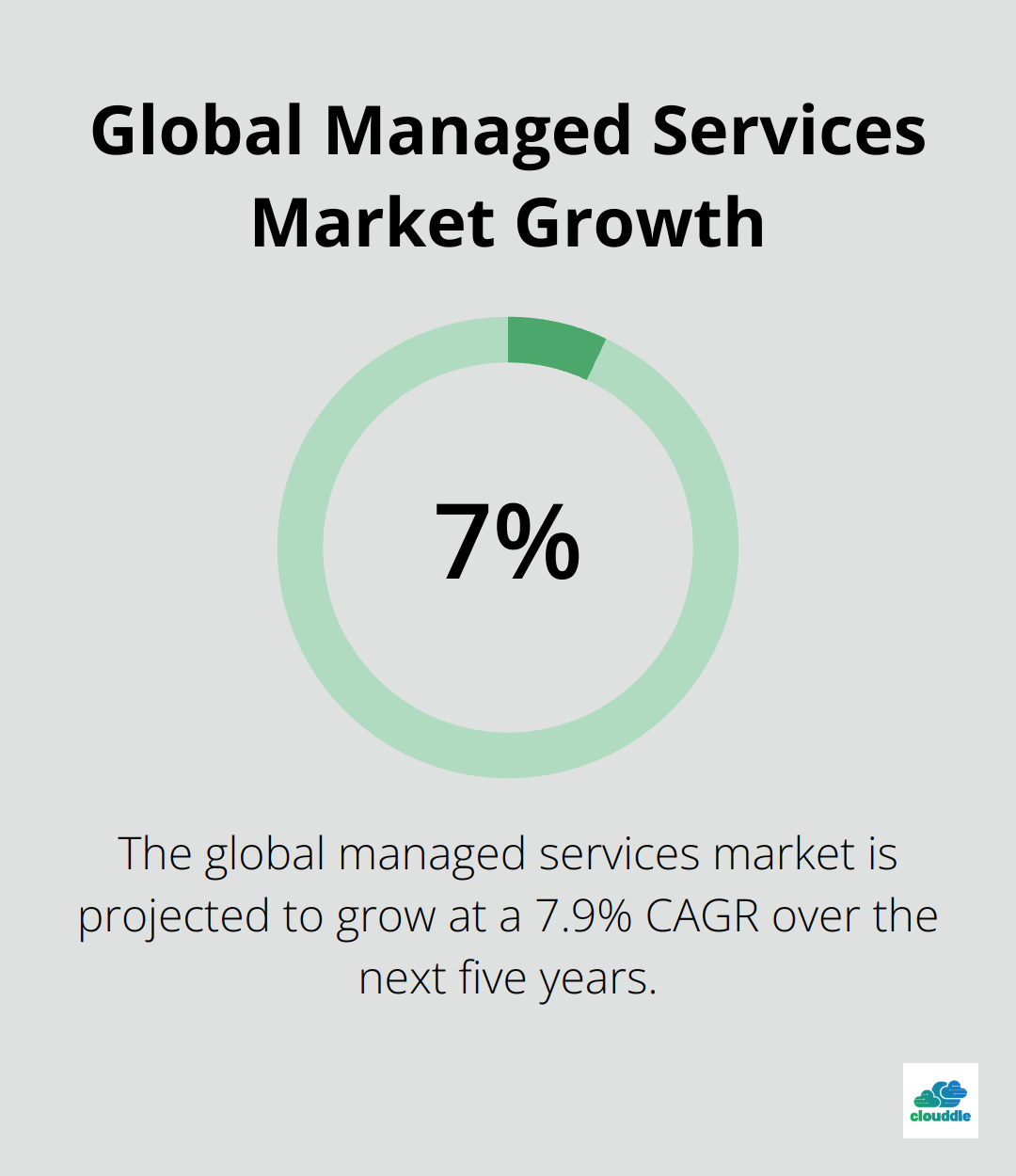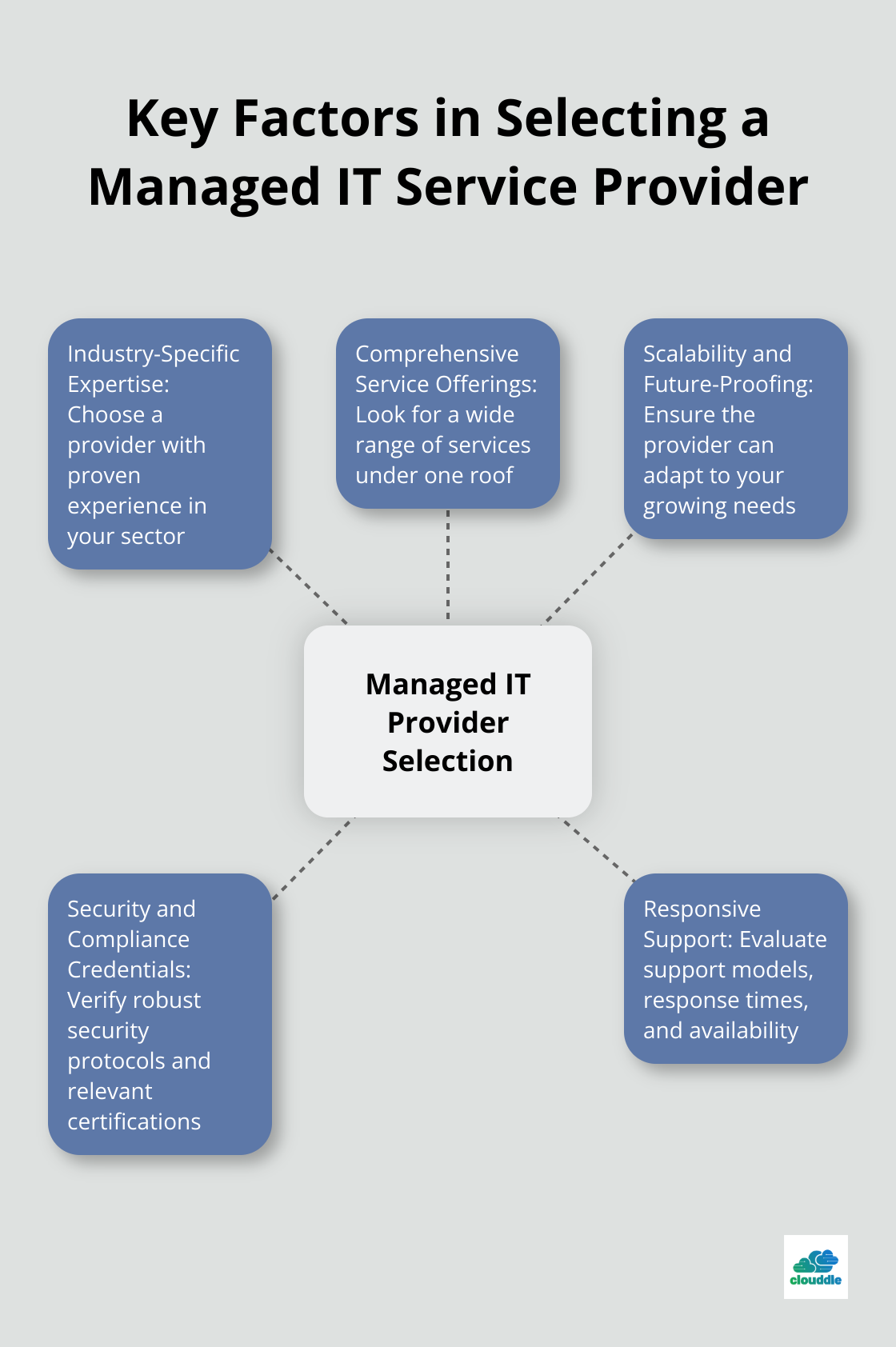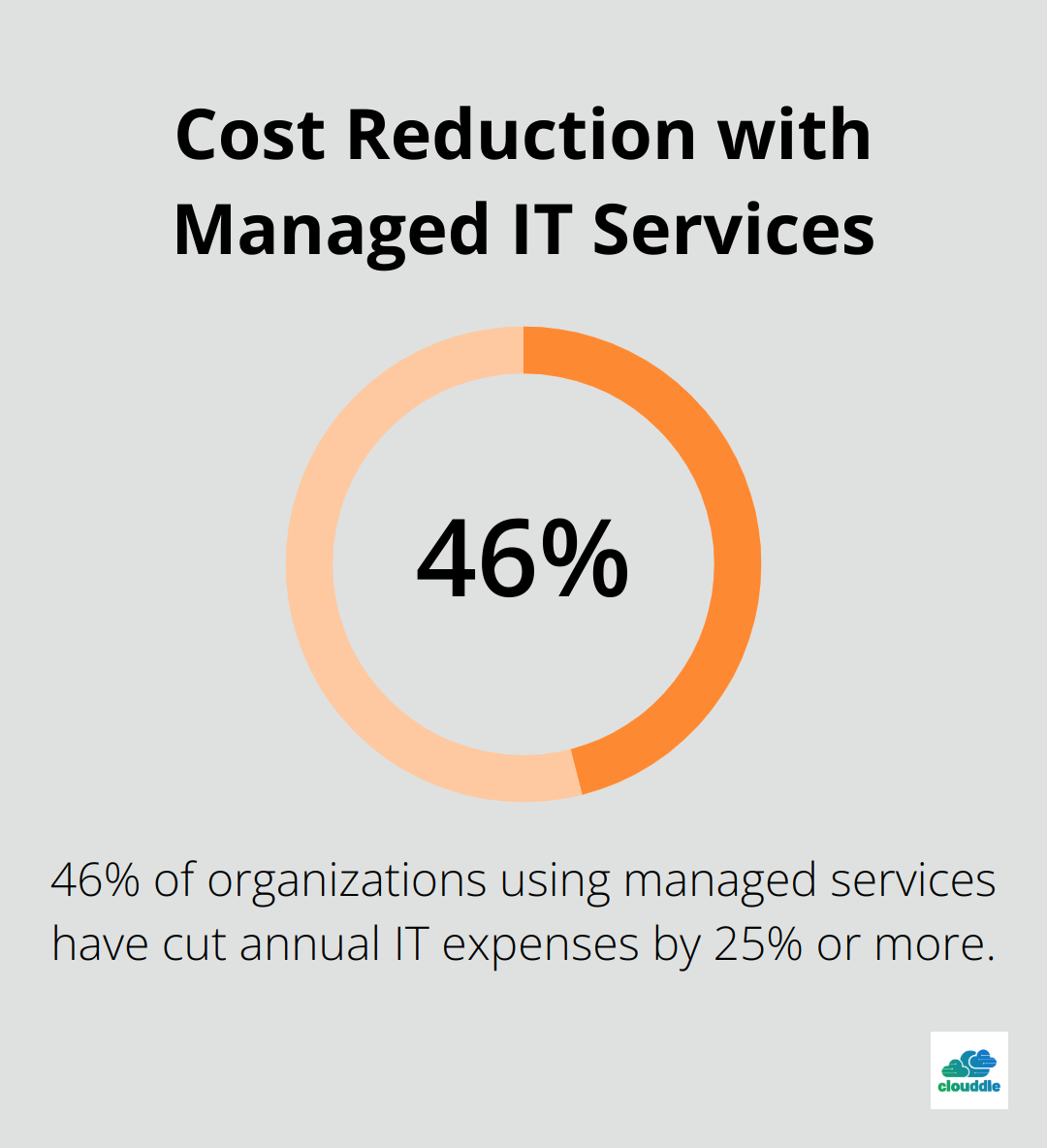Managed IT service solutions have become essential for businesses looking to streamline their operations and stay competitive in today’s digital landscape. At Clouddle, we’ve seen firsthand how the right IT partner can transform an organization’s efficiency and security.
Choosing the perfect managed IT service provider, however, can be a daunting task. This guide will walk you through the key factors to consider, helping you make an informed decision that aligns with your business goals.
What Are Managed IT Services?
The Scope of Managed IT Services
Managed IT services represent a strategic approach to outsourcing a company’s technology needs. These services encompass a wide range of technology-related tasks, including network monitoring, cybersecurity, cloud computing, data backup and recovery, and help desk support. The global managed services market is projected to reach USD 354.8 billion over the next five years, registering a Compound Annual Growth Rate (CAGR) of 7.9%.

Common Types of Managed IT Services
Different providers offer various services, but some of the most common include:
- Network Management: This service involves the monitoring and maintenance of a company’s network infrastructure.
- Cybersecurity: With the rising threat of cyber attacks, many providers offer robust security solutions. Cybersecurity Ventures expects global cybercrime costs to grow by 15 percent per year over the next five years, reaching $10.5 trillion USD annually by 2025.
- Cloud Services: As businesses transition to the cloud, managed service providers assist with migration, management, and optimization.
- Help Desk Support: This service provides employees with technical assistance when they need it.
Benefits of Outsourcing IT Management
Outsourcing IT management offers several advantages:
- Cost Efficiency: Companies using managed IT services can potentially reduce their annual IT costs.
- Access to Expertise: Companies gain access to a team of IT professionals with diverse skills and experience.
- Improved Security: Managed service providers typically offer advanced security measures (often out of reach for smaller in-house IT teams).
- Focus on Core Business: By offloading IT tasks, teams can concentrate on strategic initiatives that drive growth.
- Scalability: As businesses grow, IT services can easily scale to meet new demands.
Industry-Specific Solutions
While many providers offer these benefits, some specialize in tailoring their services to specific industries. For example, Clouddle focuses on sectors like hospitality and senior living, ensuring clients receive the most relevant and effective IT solutions for their business.
As we move forward, it’s important to consider the key factors in selecting the right managed IT service provider for your specific needs. Let’s explore these factors in the next section to help you make an informed decision.
How to Select the Right Managed IT Service Provider
Choosing the perfect managed IT service provider can significantly impact your business operations. Companies thrive with the right partner and struggle with the wrong one. This chapter will focus on the key factors to consider when making this critical decision.

Industry-Specific Expertise Matters
A provider with a proven track record in your industry should top your list. For example, if you operate in the hospitality sector, you’ll want a partner who understands the unique challenges of managing guest Wi-Fi, property management systems, and data security in a hotel environment.
Comprehensive Service Offerings
The best providers offer a wide range of services under one roof. This approach eliminates the need to juggle multiple vendors and ensures seamless integration across your IT infrastructure. Look for providers that combine networking, entertainment, and security services in their offerings, providing a one-stop solution for your business needs.
Scalability and Future-Proofing
Your IT needs will evolve as your business grows. Try to find a partner who can adapt their services to your changing needs. Ask potential providers about their capacity to handle increased workloads, add new services, and support your expansion plans.
Security and Compliance Credentials
In an era of increasing cyber threats, your IT partner’s security measures are paramount. Verify that potential providers have robust security protocols and relevant industry certifications. For regulated industries like healthcare or finance, ensure they understand and can help you maintain compliance with standards like HIPAA or PCI DSS.
Responsive Support
When IT issues arise, every minute counts. Evaluate potential providers’ support models, response times, and escalation procedures. Look for 24/7 support availability and ask about their average resolution times for different types of issues.
The next chapter will guide you through the process of evaluating managed IT service providers, helping you make an informed decision that aligns with your business goals and sets you up for long-term success in the digital landscape.
How to Evaluate Managed IT Service Providers
Assess Their Technology Stack
Start your evaluation by examining the provider’s technology stack. A strong provider should use cutting-edge tools and have partnerships with leading technology companies. For example, if you operate in the hospitality industry, look for providers who partner with top-tier networking equipment manufacturers and have experience with property management systems.
Ask potential providers about their approach to emerging technologies like AI and machine learning. Worldwide generative AI spending is expected to total $644 billion in 2025, an increase of 76.4% from 2024, according to a forecast by Gartner, Inc. A forward-thinking provider should have a plan to incorporate these technologies into their services.
Scrutinize Their Track Record
Don’t take the provider’s word for it – look for concrete evidence of their success. Request case studies that demonstrate their ability to solve problems similar to yours. Pay special attention to results in your industry. For instance, if you work in senior living, look for examples of how they’ve improved connectivity and security in similar facilities.
Client testimonials can also provide valuable insights. Look for testimonials from businesses of similar size and industry to yours. If possible, ask the provider if you can speak directly with some of their current clients. This can give you unfiltered feedback about the provider’s strengths and weaknesses.
Understand Their Pricing Structure
Pricing models for managed IT services can vary widely. Some providers charge a flat monthly fee, while others use a per-device or per-user model. Some may also charge extra for services like after-hours support or on-site visits.
Ask for a detailed breakdown of costs and what’s included in each pricing tier. Be wary of providers who lack transparency about their pricing or who try to lock you into long-term contracts without flexibility. Nearly half (46 percent) of organizations using managed services have cut their annual IT expenses by 25 percent or more, according to a new study. Make sure you understand how the provider’s pricing model will impact your bottom line.

Meet the Team
While technology is important, the people behind it are equally vital. Arrange site visits or video calls to meet the team who will handle your account. This gives you a chance to assess their expertise firsthand and see if their working style aligns with your company culture.
Pay attention to how well they communicate technical concepts. Can they explain complex ideas in terms you understand? This is essential for a successful long-term partnership. Also, ask about their training and certification programs. A provider that invests in ongoing education for their staff is more likely to stay ahead of the curve in the fast-evolving IT landscape.
Evaluate Security Measures
In today’s digital landscape, robust security measures are non-negotiable. Ask potential providers about their security protocols, data protection measures, and disaster recovery plans. Inquire about their compliance certifications (e.g., ISO 27001, SOC 2) and how they stay updated with the latest security threats and regulations.
Try to understand their incident response procedures. How quickly do they detect and respond to security breaches? What measures do they have in place to prevent data loss? A provider with a strong security focus will be able to articulate their approach clearly and provide examples of how they’ve handled security incidents in the past.
When you evaluate providers, consider factors such as their Service Level Agreements (SLAs) and how well they align with your business needs. This can give you a clear understanding of the level of service you can expect.
Final Thoughts
Selecting the right managed IT service solutions can significantly impact your business’s efficiency, security, and growth potential. The ideal provider should meet your current needs and have the capacity to grow with your business. They should offer cutting-edge technology, demonstrate a proven track record in your industry, and provide transparent pricing models.
Security is paramount in today’s digital world. Your chosen provider must have robust security protocols, relevant certifications, and a clear incident response plan. They should protect your data, ensure compliance with industry regulations, and quickly address any security concerns.
At Clouddle, we understand the importance of tailored IT solutions for industries like hospitality, multi-family dwelling, and senior living. Our Network as a Service (NaaS) approach combines networking, entertainment, and security services to streamline operations and boost revenue (all without initial investment). We provide reliable connectivity, robust security, and 24/7 support, allowing you to focus on growing your business in an increasingly connected world.


